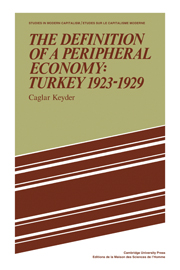2 - Integration into the world economy through agriculture
Published online by Cambridge University Press: 06 July 2010
Summary
Introduction
We shall now offer an analysis of the agricultural sector during the period starting with the foundation of the Republic in 1923 and ending with the onset of the world depression. Our objective is to identify and describe the structure of a peripheral agricultural sector and to discover its role in the process of integration into the world economy. This perspective requires a discussion of the degree and modes of commercialisation in agriculture and the structure imposed through commercialisation. Of the factors which influence the pace and the manner of commercialisation, the most important is land tenure. Land tenure, however, itself is modified under the impact of the market to better accommodate commercialisation. We shall argue that commodity production increased in small peasant farms as well as in larger farms. This hypothesis will be discussed through an analysis of production patterns and the distribution of cultivable land under different crops.
After this treatment of agriculture as a sector of economic activity, we shall discuss the role of the state in effecting developments inside the agricultural sector. We will treat specific policies of the state relating to the availability and pricing of inputs; transportation policy as a means of facilitating commercialisation; tax-policy as a means of influencing the structure of agricultural production. The chapter concludes with an evaluation of the development of agricultural output, and the degree of agriculture's integration into the world market.
- Type
- Chapter
- Information
- The Definition of a Peripheral Economy: Turkey 1923–1929 , pp. 11 - 45Publisher: Cambridge University PressPrint publication year: 1981



